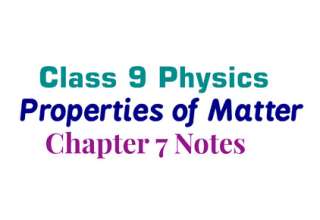This post contains Notes of Physics for Class 9 for students of 9th grade. Here, you will find the 9th Class Physics Chapter 4 Notes, Numerical and Short questions with Answers. This chapter’s name is Turning effect of Forces. These solved Numerical and Questions are for practice. However, students should prepare more study material besides these notes.
9th Class Physics Chapter 4 Notes- Numerical and Short Questions
you may also like: Short Questions of Chapter 3 – Short Questions of Chapter 5
Q.1: Define: (i) Resultant Vector. (ii) Centre of gravity.
Ans:
(i) Resultant vector: The vector whose effect is the same as the combined affect of a number of vectors is called the resultant vector.
(ii) Centre of gravity: A point where the whole weight of the body appears to act vertically downward is called centre of gravity of a body.
Q.2: Differentiate between torque and couple.
Ans.
Torque: The turning effect of a force is called torque.
Couple: A Couple is formed by two unlike parallel forces of the same magnitude but not along the same line.
Q.3: Why the height of vehicles is kept as low as possible?
Ans. The height of vehicles is kept lowest as possible so that its centre of gravity remains close to its base to get more stability.
Q.4: Define the axis of rotation.
Ans. Consider a rigid body rotating about a line. The particles of the body move in circles with their centres all lying on this line. This line is called the axis of rotation of the body.
Q.5: Define torque and write its unit.
Ans. The turning effect of a force is called torque.
Unit: Nm
Q.6 Define centre of gravity.
Ans. A point where the whole weight of the body appears to act vertically downward is called centre of gravity of a body.
Q.7: Define perpendicular components.
Ans. If a force is formed from two mutually perpendicular components then such components are called its perpendicular components.
Q.8: What is the difference between like and unlike forces?
Ans.
Like Forces: Like parallel forces are the forces that are parallel to each other and have the same direction.
Unlike forces: Unlike parallel forces are the forces that are parallel but have directions opposite to each other.
Q.9: Why a body cannot be in equilibrium due to a single force acting on it?
Ans. A single force acting on a body is not balanced and produces acceleration. Therefore, in the presence of a single force body cannot be in equilibrium.
Q.10: What is the difference between the rigid body and axis of rotation?
Ans.
Rigid body: If the distances between all pairs of particles of the body do not change by applying a force then it is called a rigid body.
Axis of rotation: Consider a rigid body rotating about a line. The particles of the body move in circles with their centres all lying on this line. This line is called the axis of rotation of the body.
Q.11: Define the centre of mass.
Ans. Centre of the mass of a system is such a point where an applied force causes the system to move without rotation.
Q.12: Differentiate between the axis of rotation and moment arm.
Ans.
Axis of rotation: Consider a rigid body rotating about a line. The particles of the body move in circles with their centres all lying on this line. This line is called the axis of rotation of the body.
Moment arm: The perpendicular distance between the axis of rotation and the line of action of the force is called the moment arm of the force.
Q.13: Write mathematical form of the condition of equilibrium.
Ans. ΣF = 0, Στ = 0
Q.14: What is the principle of moments?
Ans: A body is balanced if the sum of clockwise moments acting on the body is equal to the sum of anticlockwise moments acting on it.
Q.15: A force of 100N is applied perpendicularly on the spanner at a distance of 10 cm from a nut. Find the torque produced by force.
Ans.
F = 100 N
r = 10cm = 10/100 m = 0.1m
τ = r x F
τ = 0.1 x 100 = 10 Nm
Q.16: What is meant by resolution of force?
Ans. Splitting up of a force into two mutually perpendicular components is called the resolution of that force.
Q.17: Define a neutral equilibrium.
Ans. If a body remains in its new position when disturbed from its previous position, it is said to be in a state of neutral equilibrium.
Q.18: Explain stable equilibrium by giving example.
Ans. A body is said to be in stable equilibrium if after a slight tilt it returns to its previous position.
Example: When the block is tilted, its centre of gravity G rises. If the vertical line through G passes through its base in the tilted position.
9th Physics MCQs of Chapter 4 are also available.
Above available Short Questions are taken from Al-Hassan Super Notes Physics (English Medium) – IX





